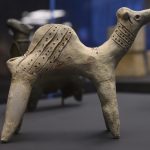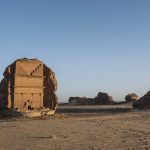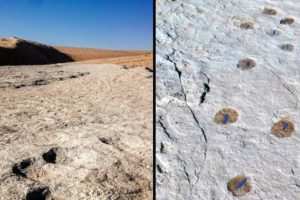
Archaeologists who unearthed the remains of a 3,500-year-old pyramid-shaped mausoleum in the Kazakh steppes, have now opened its funerary chamber, finding a skull, human bones and Bronze Age pottery.Wrongly hailed by several media outlets as the world’s first pyramid, the structure dates back to the 14 th to 12th century BC and contains five walls that gradually rise toward the center.
The structure appears to resemble the step pyramid of Djoser, which was built about 4,700 years ago at the site of Saqqara in Egypt.
Considered the first Egyptian pyramid, the Djoser monument originally stood 203 feet tall, with a base of 358 by 410 feet.

By contrast, the Kazakhstan “pyramid” was much smaller. Made from stone, earth and slabs in the outer side, it measured about 6.6 feet high and about 49 by 46 feet long.
“It was built by the Begazy-Dandybay culture of Late Bronze Age in Kazakhstan,” Viktor Novozhenov, an archaeologist with the Saryarka Archaeological Institute at Karaganda State University in Kazakhstan, told Discovery News.

The tribes of the Begazy-Dandybay culture of Central Kazakhstan are mainly known for their unique monumental architecture. Their megalithic structures were used as tombs for people of the highest social rank.
About 18 of such megalithic mausolea have been found so far. They consist of two or three perimeter walls made by stone masonry or by stone slabs weighting up to 3 tons.
The central chamber had a stone roof supported by up to 14 square pillars and usually contained an impressive sarcophagus and an earthen altar.
The newly discovered pyramid-shaped mausoleum is completely different in shape and size. It has however a funerary chamber at the center, which possibly housed the clan leader.

“Already 27 graves of nobles or relatives to the leader have been found around the mausoleum,” Novozhenov said.
As the archaeologists opened the chamber, they immediately realized it was heavily robbed long ago.
On the floor, there were scattered human bones, a skull and Bronze Age objects such as a knife and some jugs. Another skull was found in a nearby grave.

“These findings confirm our preliminary dating of 14 th -12th century ВС,” Novozhenov said.
He added that one skull might belong to a male individual, while the other to a female, but more research, including DNA analysis, is needed to solve the mystery of their identities.
“The finding can provide us with unique information about Eurasia’ steppe tribes in the Late Bronze Age, a period when the Saka and Cimmerians mentioned by Herodotus emerged,” Novozhenov said.
“Later, in the 9th to 8th century BC, these tribes migrated to western Eurasia up to the Black Sea coast, forming the Persian Scythian-Sakas community,” he added.
Source: Discovery News [August 20, 2016]















